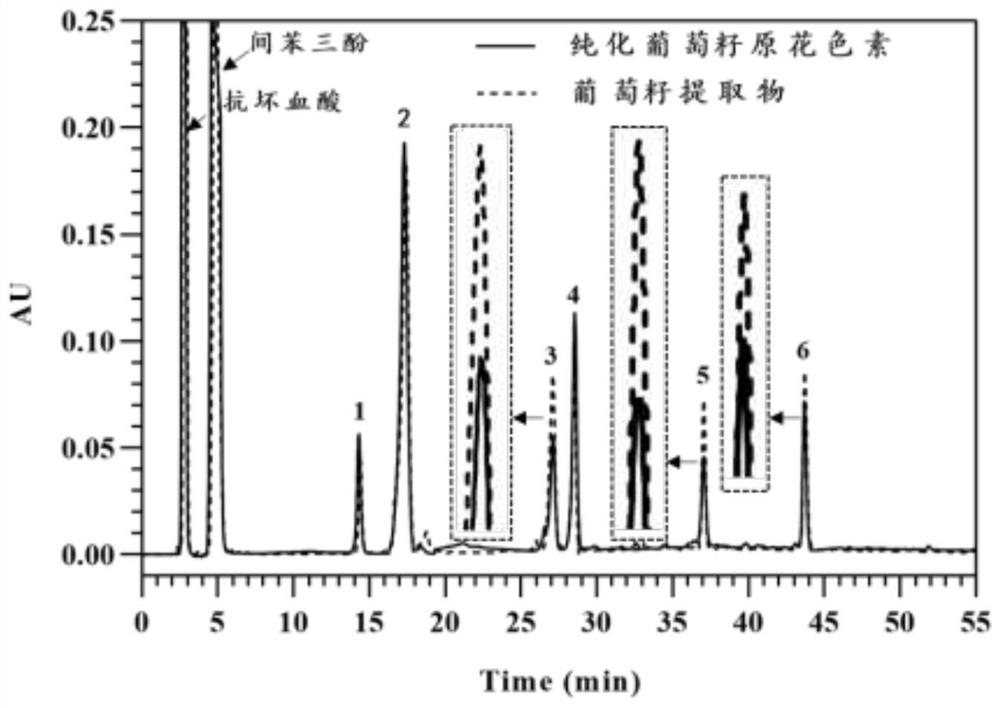Method for analyzing proanthocyanidin structure through combination of hydrophilic interaction and reversed-phase liquid chromatography
A reversed-phase liquid chromatography and proanthocyanidin technology, which is applied in the field of rapid analysis of proanthocyanidin structure, can solve the problems of time-consuming and inaccurate proanthocyanidin structure analysis results, and achieve the effect of improving analysis speed and accuracy
- Summary
- Abstract
- Description
- Claims
- Application Information
AI Technical Summary
Problems solved by technology
Method used
Image
Examples
Embodiment 1
[0156] Embodiment 1. A method for analyzing the structure of proanthocyanidins by combining hydrophilic interaction chromatography (Hilic) and reversed-phase liquid chromatography (RPLC). The sample to be tested containing proanthocyanidins is grape seed extract, and the following steps are carried out in sequence :
[0157] 1), flavan-3-ol monomer analysis:
[0158] Hilic analyzes (epi)catechin and its gallate in the sample solution to be tested, specifically as follows:
[0159] Accurately weigh 5.0 mg of grape seed extract, dissolve it in 1.0 mL of 97% acetonitrile aqueous solution, and use it as the sample solution to be tested; after passing through a 0.22 μm filter membrane, use the above-mentioned "1.1), Hilic analysis conditions" to detect, and then the obtained The peak area is correspondingly substituted into the formula obtained in the above "1.2)" to obtain the concentration of these 4 in the solution.
[0160] The Hilic analysis chromatogram is as follows figur...
Embodiment 2
[0183] Embodiment 2, cancel the step 3 in the above-mentioned embodiment 1 about "detecting the anthocyanidin of the acid degradation product to be analyzed at 550nm (for the acid degradation by-product)",
[0184] Therefore, the specific calculation formula of step 4) is correspondingly changed as follows:
[0185]
[0186] In order to compare the method of the present invention with the traditional proanthocyanidin structure analysis method, the traditional method will be described in detail below.
[0187] Comparative example, traditional method:
[0188] 1) Purification of proanthocyanidins: Accurately weigh 1.0g of grape seed extract, dissolve in 4.0mL 50% methanol aqueous solution, load the sample on a Sephadex LH20 column equilibrated with 50% methanol aqueous solution, and elute 5 columns with 50% methanol aqueous solution volume, collect eluate 1, then elute with 70% acetone aqueous solution for 3 column volumes, collect eluate 2, and eluate 2 is dried to obtain p...
PUM
 Login to View More
Login to View More Abstract
Description
Claims
Application Information
 Login to View More
Login to View More - R&D
- Intellectual Property
- Life Sciences
- Materials
- Tech Scout
- Unparalleled Data Quality
- Higher Quality Content
- 60% Fewer Hallucinations
Browse by: Latest US Patents, China's latest patents, Technical Efficacy Thesaurus, Application Domain, Technology Topic, Popular Technical Reports.
© 2025 PatSnap. All rights reserved.Legal|Privacy policy|Modern Slavery Act Transparency Statement|Sitemap|About US| Contact US: help@patsnap.com



